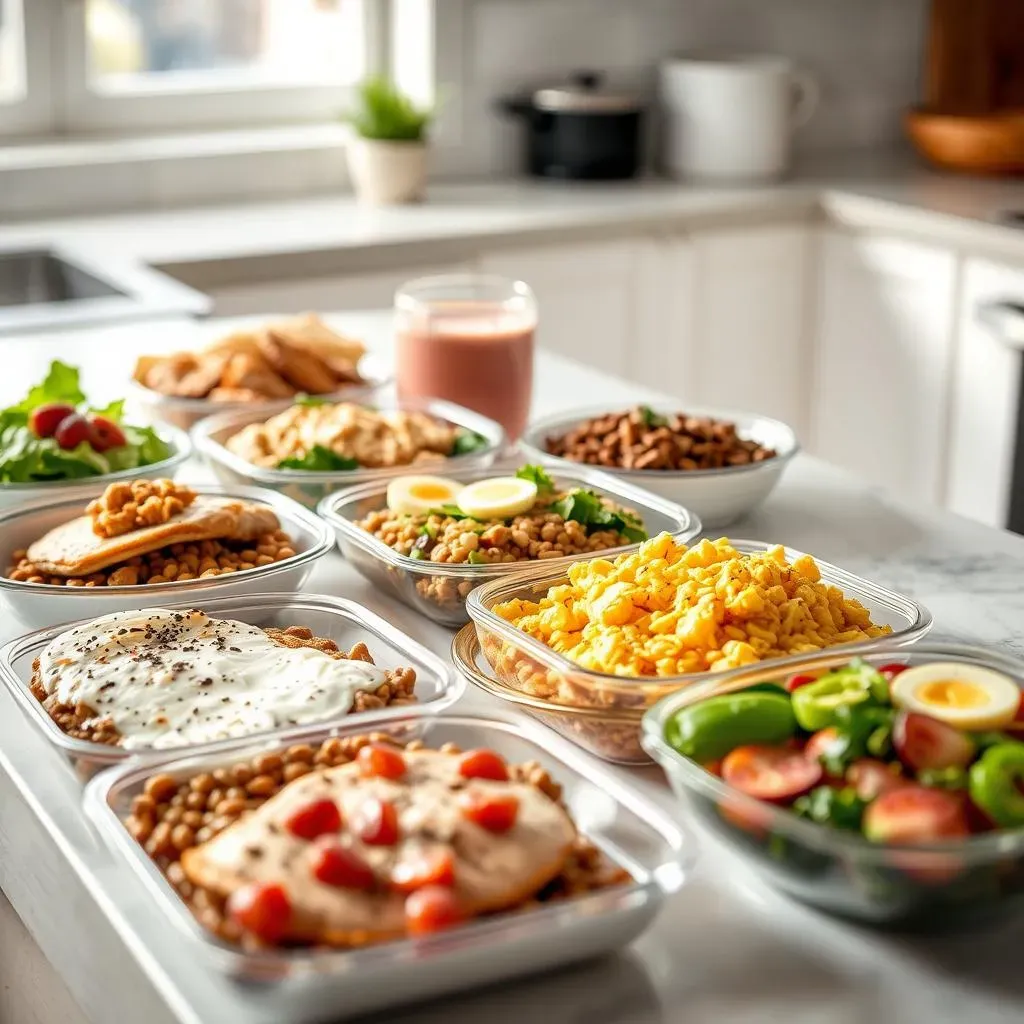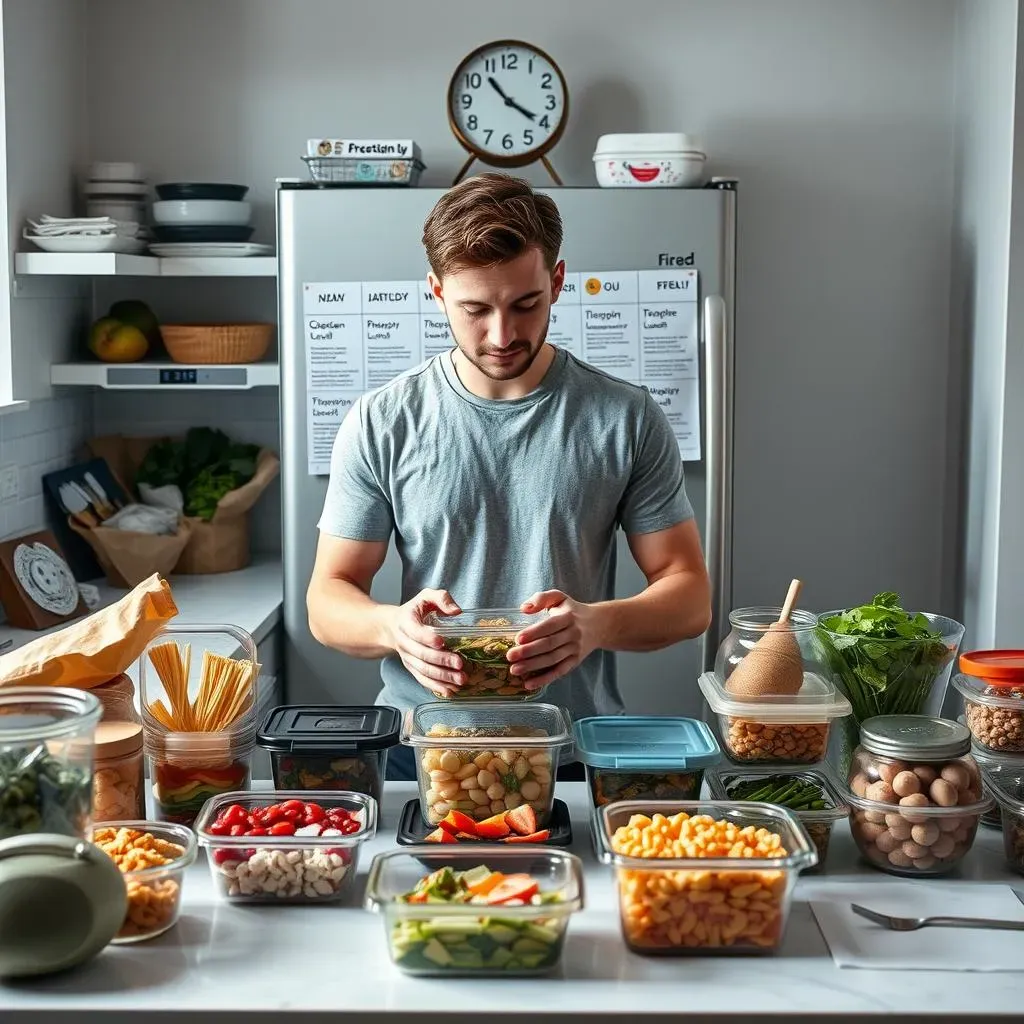Table of Contents
Gaining weight healthily can be a challenge, but it doesn't have to be a struggle! This article is your ultimate guide to achieving your weight gain goals through the power of high-protein meal prepping. We'll break down everything you need to know, from understanding your individual caloric needs to crafting a delicious and effective meal plan. Forget bland, boring meals; we're diving into exciting high-protein recipes that will keep you satisfied and energized. We'll cover a week's worth of meal prep ideas, ensuring variety and convenience. We'll also share essential tips and tricks to make meal prepping a breeze, saving you time and money while maximizing your results. Ready to transform your physique and fuel your body with the right nutrients? Let's explore the world of high protein meal prep ideas for weight gain together!
Understanding Your Caloric Needs for Weight Gain

Understanding Your Caloric Needs for Weight Gain
Calculating Your Basal Metabolic Rate (BMR)
Before you start piling on the protein, you need to figure out how many calories your body burns at rest. This is your Basal Metabolic Rate (BMR). Several online calculators can help estimate this based on your age, sex, height, and weight. Think of your BMR as your body's engine idling – it's the minimum energy needed to keep you ticking over. Once you have your BMR, we can start building from there. It’s a crucial first step for any successful weight gain plan, whether you're into bodybuilding or just want to pack on a few pounds. Remember, accuracy is key here; a slightly off BMR can significantly impact your results. Getting this right is like having the right foundation for a house – you want it strong and stable!
Don't forget that your activity level also plays a huge role. Are you a couch potato or an ultra-marathoner? Your daily calorie needs will vary drastically depending on your physical activity. If you're looking to gain weight, you need a surplus of calories, meaning you consume more than your body burns. This surplus provides the energy needed for muscle growth and overall weight gain. For detailed meal planning, check out our high-protein meal prep ideas for muscle gain.
Factor | Impact on Caloric Needs |
|---|---|
BMR | Base level of calorie expenditure |
Activity Level | Significant increase or decrease based on exercise |
Digestion | Adds a small percentage to daily needs |
Adding Activity and the Thermic Effect of Food
Now, let's talk about your activity level. That sedentary BMR is just the starting point. Your daily activities, from walking to weightlifting, significantly increase your calorie burn. This is where things get interesting! You need to factor in the energy your body expends on activities beyond just resting. Consider your workout intensity and duration. If you're hitting the gym hard, you'll need more calories to fuel those intense sessions. This is where a well-planned high-protein diet comes in handy. Protein is essential for muscle repair and growth, and it also helps you feel fuller for longer, preventing those extra snack attacks.
We also need to consider the thermic effect of food (TEF). This is the energy your body uses to digest, absorb, and process the food you eat. It's a small percentage, but it adds up! Different foods have different TEFs; protein generally has a higher TEF than carbohydrates or fats. So, focusing on high-protein meals, like those you can find in our chicken-based meal prep guide, not only provides the building blocks for muscle growth but also boosts your metabolism slightly.
- Calculate your BMR.
- Estimate your activity level multiplier.
- Account for the thermic effect of food.
Fine-Tuning Your Calorie Target for Weight Gain
You've got your BMR, you've considered your activity level, and you've factored in TEF. Now it's time to determine your daily calorie target for weight gain. A general guideline is to add 250-500 calories to your total daily energy expenditure (TDEE). This creates a calorie surplus, essential for weight gain. However, this is just a starting point. You might need to adjust this number based on your individual response. Some people gain weight more easily than others. You'll need to monitor your progress closely and make adjustments as needed. Remember, consistency is key; small, gradual adjustments are better than drastic changes.
Keep in mind that weight gain isn't just about calories; it's also about the quality of those calories. Focus on nutrient-dense foods, including plenty of protein, healthy fats, and complex carbohydrates. These provide the building blocks for muscle growth and overall health. For inspiration, check out our beef-based meal prep recipes for some tasty ideas. Remember, consistent monitoring and adjustments are crucial for optimal results. Don't be afraid to experiment and find what works best for your body.
HighProtein Meal Prep Recipes: A Week's Worth of Deliciousness

HighProtein Meal Prep Recipes: A Week's Worth of Deliciousness
Breakfast Powerhouses
Let's kick things off with breakfast! Think high-protein options that will keep you full and energized throughout the morning. Overnight oats with protein powder and berries are a fantastic choice. They're quick to prepare, packed with nutrients, and incredibly versatile. You can easily change up the fruits and nuts to keep things interesting. Another great option is a protein smoothie. Blend together your favorite protein powder, milk (dairy or plant-based), spinach, and some fruit. It's a quick and easy way to get a protein boost before your day begins. Remember, breakfast is the most important meal, especially when you're trying to gain weight! For more ideas, check out our high-protein breakfast meal prep ideas.
Scrambled eggs with some whole-wheat toast and avocado are another winner. Eggs are a fantastic source of protein and essential nutrients. Add some cheese or smoked salmon for extra flavor and protein. If you're vegetarian or vegan, tofu scramble is a great alternative. You can easily customize it with various vegetables and spices. Remember, variety is key to keeping your meal prep interesting and preventing boredom. Don't be afraid to experiment with different flavors and combinations to find what you enjoy the most. This is where your culinary creativity really shines!
- Overnight Oats with Protein Powder
- Protein Smoothies
- Scrambled Eggs with Whole-Wheat Toast
Lunchtime Champions
Lunch is your midday refueling station. You need something substantial to keep you going until dinner. Chicken breast with quinoa and roasted vegetables is a classic high-protein lunch option. Chicken is a lean protein source, quinoa provides complex carbohydrates, and roasted vegetables add essential vitamins and minerals. You can easily prep a large batch of chicken and roasted vegetables on the weekend and portion them out for the week. Another great option is a hearty lentil soup. Lentils are an excellent source of plant-based protein and fiber, keeping you feeling full and satisfied. Add in some chopped vegetables for extra nutrients. Remember, lunch should be a balanced meal that provides sustained energy. Don't be afraid to experiment with different combinations to keep things exciting.
For a quicker option, consider prepping some high-protein salads. Combine grilled chicken or fish with leafy greens, various vegetables, and a light vinaigrette dressing. You can also add beans, chickpeas, or lentils to increase the protein content. Remember to keep your salads interesting by using a variety of vegetables and dressings. For additional vegetarian options, take a look at our vegetarian high-protein meal prep ideas. Remember, meal prepping is all about finding a balance between convenience, nutrition, and enjoyment. Don't be afraid to experiment and find what works best for you.
Meal | Protein Source | Carbohydrate Source | Vegetables |
|---|---|---|---|
Chicken & Quinoa | Chicken Breast | Quinoa | Roasted Vegetables |
Lentil Soup | Lentils | Whole Wheat Bread | Carrots, Celery, Onions |
High-Protein Salad | Grilled Chicken/Fish | Leafy Greens | Variety of Vegetables |
Tips and Tricks for Successful HighProtein Meal Prepping

Tips and Tricks for Successful HighProtein Meal Prepping
Planning is Key: Your Meal Prep Roadmap
Successful high-protein meal prepping starts with a solid plan. Before you even hit the grocery store, map out your meals for the week. Consider your schedule, your preferences, and the recipes you'll be using. This prevents last-minute scrambles and ensures you have everything you need. Think of it like building a house—you wouldn't start constructing without blueprints, right? A detailed plan ensures you’re not wasting precious time and ingredients. For more recipe inspiration, check out our ground turkey meal prep ideas.
Next, create a comprehensive shopping list. This prevents impulse buys and ensures you stick to your plan. Having a list saves you time and money at the grocery store, avoiding those tempting but unnecessary additions. Once you’ve got your list, stick to it! This organized approach streamlines the entire process, making meal prep less daunting and more efficient. Remember, preparation is half the battle! For more efficient planning tips, explore our bodybuilding meal prep guide.
- Create a weekly meal plan.
- Make a detailed shopping list.
- Stick to your list!
Smart Shopping: Maximizing Your Protein Intake
When shopping, prioritize high-protein foods that fit your dietary preferences and your meal plan. Lean meats (chicken, turkey, beef), fish, eggs, beans, lentils, tofu, and Greek yogurt are all excellent choices. Don't be afraid to experiment with different protein sources to keep things interesting. Remember, variety is the spice of life (and meal prepping)! Don’t forget to check out our vegan high-protein recipes for some plant-based inspiration.
Also, consider buying in bulk for cost savings. Larger quantities of staples like rice, quinoa, and frozen vegetables are often cheaper per unit. This smart shopping strategy helps stretch your budget further, allowing you to focus on higher-quality protein sources without breaking the bank. Buying in bulk is a great way to save money without sacrificing quality or convenience. For smart shopping tips tailored to your budget, see our high-protein meal prep for women guide. It also addresses budget-friendly options.
Food Group | High-Protein Options |
|---|---|
Meat | Chicken, Turkey, Beef, Fish |
Plant-Based | Beans, Lentils, Tofu, Quinoa |
Dairy | Greek Yogurt, Cottage Cheese |